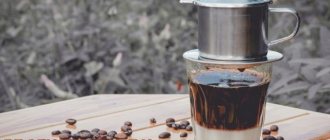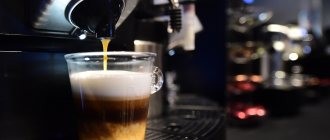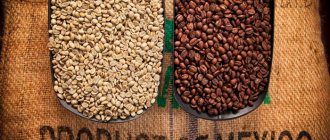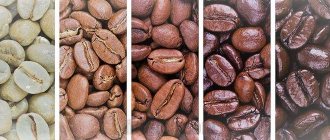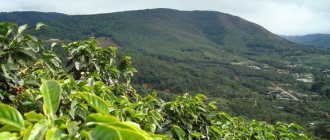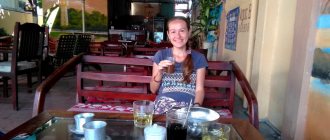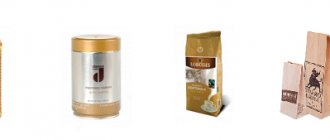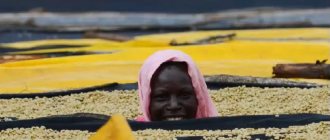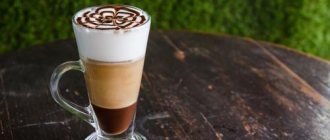Santo Domingo
Tourists who have visited the Dominican Republic talk with admiration about the unforgettable taste of Santo Domingo coffee. It is produced by Industrias Banilejas SAS, whose share of the country’s domestic market is 95%, so Santo Domingo, without exaggeration, can be called the main coffee of the Dominican Republic.
Historical reference. Coffee exports are one of the most important sources of income for the Dominican Republic. Locals love this drink very much; they prepare it mainly in a geyser coffee maker; in the Dominican Republic they call it Greca.
But until recently, the situation with roasted Dominican coffee was dire. Even in the second half of the 20th century, the best coffee was exported green, and what remained for domestic consumption was roasted without using technology.
In 1945, Dominican entrepreneur Manuel de Jesus Perello Abreu created the company Industrias Banilejas (abbreviated as Induban), which was engaged in the wholesale sale of raw coffee. The company was located in the city of Bani.
Later, the son of the company’s founder, Senor Rafael Perello, recalled: he and his father worked a lot and did not even suspect that they were starting a real revolution in the country. At first, the Perellos came to the conclusion that roasted coffee was more profitable to sell than green coffee. It was then discovered that if farmers were trained to use the correct coffee processing techniques, the quality of the beans would improve significantly. By the beginning of the 21st century, Induban had become a leader in the Dominican coffee industry.
Santo Domingo coffee is made from washed Arabica beans, the ripe berries of which are selectively picked by hand. The enterprise where coffee is roasted and packaged is equipped with the latest technology. An automated control system for the roasting and blending processes is installed here. Only the 7 largest coffee companies in the world have such equipment.
In 2022, Señor Perello opened the first educational institution for baristas in the Dominican Republic - Instituto del Café Santo Domingo. It is taught by famous baristas and tasters, winners of cupping championships.
The Perello family's business approach to marketing and advertising is interesting. Santo Domingo coffee has been produced in packaging with the same design for 70 years. Only in 2015, in honor of the anniversary, the image on the briquettes and cans was changed: now they are decorated with a stylized sun illuminating a cup of coffee and Arabica beans. The picture is pale, it gets lost against the background of bright packs of coffee from other brands. But the calculation is made on the fact that a person who has once tried Santo Domingo coffee will never betray this brand again.
Santo Domingo is almost not advertised, since it can already be purchased at any Dominican retail outlet and duty-free stores. Coffee is exported to Russia, the USA, all island states of the Caribbean, and small quantities are purchased in the Middle East.
Dominican Republic: what to bring from there?
Tourists especially love to bring rum from their holidays in the Dominican Republic. This drink is widespread in this state. Rum can be seen in stores, bars, and also at the airport. There are 15 different factories throughout the country that produce it. However, Brugal and Barcelo are considered the most famous.
was founded in 1930 by Julian Barceló in the city of Santo Domingo. Currently, this plant is located in the city of San Pedro de Macoris. The alcoholic drink is exported to more than 50 countries around the world.
As for, it was founded in 1888 by the Spaniard Andres Brugal in the city of Puerto Plata. The distillery is currently considered the third largest rum producer in the world.
Still don't know what to bring from the Dominican Republic as a gift? Pay attention to local rum. But which one is best to choose?
Barceló Imperial is a long-aged Dominican alcoholic drink. This rum was recognized as the best in the world. In addition, he twice received 97 points out of 100 from the American Institute of Beverage Testing and Testing, which is currently considered an absolute record. If you still haven’t decided what to buy in the Dominican Republic as a gift, then you can buy this high-quality rum, which is sold in a very beautiful bottle. Quite often it can be found on store shelves in a gift box. The cost will depend on the specific city in which you will purchase the gift. As a rule, you will have to pay about 30 dollars (about 2 thousand rubles) for one bottle.
But how many liters of this alcoholic drink are allowed to be exported from the Dominican Republic? If you want to buy a lot of rum, then you need to know the rules for exporting it from the country. In fact, in this state there are no restrictions on the export of drinks, but there are restrictions on the import of alcoholic beverages into Russia. It is allowed to import into the territory of our state no more than 3 liters of strong alcoholic drinks duty-free and no more than 5 liters of others. Thus, if you want to bring 5 liters of Dominican rum, you will have to pay a fee for 2 extra liters. It should also be remembered that this volume is designed for 1 person. If you are traveling together, these numbers can be multiplied by 2.
Types of coffee Santo Domingo
- Santo Domingo (briquette 453.6 g) – 100% Arabica (Typica), roast – medium. The coffee is fragrant with apple and grapes; the taste is dominated by vanilla-caramel and chocolate shades. The sourness is very weak;
- Santo Domingo Aroma (briquette 453.6 g) – 100% Arabica. Sweetish notes in the taste soften the coffee bitterness;
- Induban Gourmet (453.6 g briquette) – 100% Arabica (a mixture of bourbon and typica), medium roast. The coffee has a floral flavor.
- Santo Domingo (briquettes 453.6 g, 226 g, tin 283 g);
- Santo Domingo Espresso (briquette 453.6 g) – 100% Arabica (typica), medium roast, low acidity;
- Induban Gourmet (briquettes 453.6 g, 226 g, tin 283 g);
- Santo Domingo Descafeinado (283 g tin) – decaffeinated Arabica.
Product Description
Santo Domingo coffee appeared in the Dominican Republic thanks to French colonists. It was they who brought sprouts of unknown trees to the small island of Haiti in the Caribbean Sea three hundred years ago. Coffee plantations are located in the mountains. Here the fertile volcanic soil is rich in minerals. This circumstance, together with a special, fairly hot climate, creates favorable conditions for growing coffee trees. The Dominicans have mastered this art to perfection.
Locals love their coffee. Almost everyone drinks it - both poor and wealthy people. Santo Domingo coffee has a rich tart taste and a pleasant rich aroma with a slightly noticeable characteristic sourness. It is produced by about 50 thousand small farmers. Right on site, they carry out the initial processing of the grown fruits (washing, soaking, removing the pulp and drying). Next, the prepared product is sent to sorting stations for packaging, and from there it is sent for sale.
Types and varieties
Santo Domingo coffee mainly comes in two varieties: ground and beans. Each of them has its own advantages. Thus, the grain product has a more expressive bouquet, and the ground product is convenient to store and easy to prepare. "Santo Domingo" is the common name for Dominican coffee. Arabica beans are mainly used for its production. Depending on the region of growth, three of its most popular varieties can be distinguished:
- "Okoa." This coffee comes from the province of the same name. It has a deep taste and a pronounced aroma. This product, after brewing, gives a strong infusion with a pleasant fruity aftertaste.
- “Bani” also got its name from the region where it is bred. This is the most valuable variety of coffee beans, the distinctive feature of which is low acidity.
- "Barahona" is bred in the northwestern part of the Dominican Republic. Unlike other varieties, it is quite soft and has a rich taste, as well as an expressive deep aroma.
In production, in order to obtain the desired bouquet of taste, different varieties are mixed in certain proportions.
Paintings and carpets
Let's say right away that these are large items, so make sure you have enough space to bring them. The paintings were painted by local artists. Some of them live in a separate village near La Romana. Typically, masters depict in their paintings the sights of their native country, landscapes, portraits of political figures, and musicians. The cost of a small painting on A4 sheet is about 10-15 dollars. If the artist is more or less famous, then the cost starts from $18.
Dominican carpets are strikingly different from, say, Persian products. The main difference is the method of production. Dominicans use small scraps of fabric sewn onto the bedspread to create it. This carpet evokes associations with a cloud. In principle, it can be neatly folded and placed in a small bag. The price of such products is at least 15 dollars.
Cereal product
Some fans prefer to buy Santo Domingo coffee beans. This choice can be fully explained. The taste of the finished drink is greatly influenced by the correct grinding of the coffee beans. Even the smallest mistake made during this process can completely ruin the product. And buyers who know a lot about this prefer to do everything themselves.
For them, in Russian stores, Dominican coffee is presented in a fairly wide range:
- Aroma. This medium roast coffee is made from a blend of two types of Arabica: Bourbon and Typica. After brewing, it produces a wonderful aromatic drink with a delicate taste. At the same time, a delicate foam forms on the surface of the cup.
- Caracolillo. This is also a medium roast product, which does not contain a single Robusta grain.
- Puro Cafe. Has the same composition as Aroma. True, in this case a light degree of roasting is used.
- Café Induban Gourment includes the same two types of Arabica. But here a dark degree of roasting is already used.
Each of these products is good in its own way. The buyer can only decide how strong and rich the drink he wants to prepare for himself.
The price of pleasure
Almost all coffee produced in the Dominican Republic is produced under the Santo Domingo brand. At enterprises it is packaged mainly in vacuum foil bags weighing 453.6 grams. True, sometimes there are also smaller (227 and 100 grams) or large (1360 grams) packages. Local manufacturers rarely use traditional tin cans.
Coffee from the Dominican Republic is not often seen on the shelves of domestic stores for free sale. This is understandable. After all, such a product is not cheap at all.
When you look at the numbers in the table, it becomes clear that Dominican coffee Santo Domingo cannot be called a budget product. It is purchased mainly by those who really love the classic strong drink with a pleasant, characteristic bitterness. Recently in Russia there are more and more such people wanting to do so. People are gradually learning to appreciate quality and understand drinks.
Alcohol
Rum and other alcohol in the Dominican Republic can be bought at factories during excursions, in supermarkets, even in souvenir shops or specialty stores. Prices are not very different from each other.
Rum
You should definitely bring rum from the Dominican Republic - at least as a souvenir for friends, boss or family. Good selection, excellent quality, reasonable prices.
What rum to buy in the Dominican Republic? We recommend paying attention to 3 brands:
- Bermudez. Even the brand's 12-year-old rum costs only $19 for a 750 ml bottle.
- Brugal. A bottle of aged Dominican rum (from 6 years old) will cost 6-8 dollars for a 500 ml bottle. There are “age-appropriate” premium options.
- Barselo. Most often, tourists bring 10-year-old Bareslo Imperial rum from the Dominican Republic. This is the golden mean: high quality, inexpensive.
How to choose a good rum in the Dominican Republic? First of all, pay attention to the markings:
- Anejo – yearly aging;
- Extro Viejo – from 6 years of aging;
- Reserva Especial – the best aging (more than 10 years).
If you are on an all-inclusive holiday in the Dominican Republic, you can try rum at the hotel. Ask what drink the bartender poured you. This way you will find a good local rum to suit your taste.
Tourists often ask how much rum can be taken from the Dominican Republic, and how they can cheat. There are many reviews on the Internet about how people successfully passed customs while exceeding the limit. We do not recommend taking risks. You can take no more than 3 liters of strong alcohol per person from the Dominican Republic. You are allowed to bring no more than two into Russia. This limit should not be exceeded.
Mamajuana
Do you want to bring something traditional from the Dominican Republic that you can’t find anywhere else? Then buy a bottle or mix to make Mamajuana tincture. This is a wonderful gift from the Dominican Republic that you can bring to your parents, friends or yourself.
Locals claim that Mamajuana normalizes blood pressure, increases the body's resistance to viruses, and is an aphrodisiac. The finished tincture contains special roots, aromatic herbs, spices, red wine, rum, and honey. Mamajuana should be drunk 50 ml and savored. Or add it to cocktails.
In the Dominican Republic you can buy Mamajuana in 2 forms:
- Tincture. This option is already ready to use. When you finish drinking, leave the roots. Fill them with alcohol and honey again. A bottle of Mamajuana costs about 10-13 dollars for 500 ml.
- Dry mixture. Saves space in luggage. Buy a mixture of roots, which will need to be poured into a bottle, filled with rum, dry red wine and honey, and kept for 2 weeks. The package costs $2 and can be used for 2 years.
Liqueurs
Women from the Dominican Republic are often given rum-based liqueurs as gifts. They are less strong and aromatic. Most often, local liqueurs can be tasted in Punta Cana or Boca Chica while staying at all-inclusive hotels. Most popular flavors:
- chocolate;
- coconut;
- mango;
- banana;
- mix of tropical fruits.
A 750 ml bottle of liqueur costs about $20. It is better to buy in supermarkets or souvenir shops. In duty-free on departure from the Dominican Republic, the choice is very modest - the shelves are filled with rum.
DID YOU LIKE THE POST? TELL YOUR FRIENDS ABOUT HIM!
- 1
Unbiased opinion
What do buyers think about Santo Domingo coffee? Reviews about this product from most of them are mostly positive. Those who managed to try it at least once remembered this feeling for a long time.
The drink is very strong, rich and incredibly tasty. The characteristic aroma does not raise any doubt about the quality of the product. There is not even a hint of the presence of any synthetic components in the aftertaste. If someone finds the drink too strong, the situation can always be corrected by adding a little milk to the cup. And those who have a sweet tooth can use sugar for this. By the way, the Dominicans themselves do just that. Many of them even brew coffee using sweet water, although this is contrary to technology. For people who have stomach problems, it is better to buy medium roast coffee. Possessing excellent tonic properties, it does not cause any harm to internal organs. Any concerns about this are in vain.
Prohibitions
Some products cannot be exported from the Dominican Republic. Remember this so that you are not detained at the airport. There are also restrictions on the export of alcohol or tobacco. Here's what you can't take out of a tropical country:
- Local bills. If you want to give someone a Dominican peso, it is better to immediately abandon this idea.
- Lots of alcohol and tobacco. Limits on tobacco products: no more than 250 grams in total (or 200 cigarettes and 50 cigars). Restrictions on alcoholic products: no more than three liters per citizen (in this case, strong alcohol should not exceed a liter).
- Meat and dairy products.
- Objects that a tourist has recovered from the bottom of the Caribbean Sea or Atlantic Ocean. It is prohibited to take some types of orchids with you. Also, you cannot transport the heart of the palm. For this you can run into a large fine.
- Medicines that contain narcotic components, pornographic materials, weapons, narcotic drugs. In general, we are talking about a standard list of things and objects prohibited for export from any country.
If you bring something by accident (for example, you forgot to put out a peso), do not argue at the airport in the Dominican Republic. Better explain yourself calmly. If the offense is not serious, you will simply leave the item at the airport and calmly catch the plane.
And don't forget that most Dominican shops open at 8 or 9 am. They all work until the evening (until 18.00). Small shops are closed on Sunday, and on Saturdays they are limited to 13.00. If you want to buy something on a weekend, then go to the shopping center. They work every day. On Sunday, shopping centers close an hour earlier (at 20.00).
Santo Domingo Molido
The Santo Domingo Molido coffee deserves special attention. The manufacturer of this product is Induban.
This medium roast ground coffee has a delicate, balanced flavor with a slight hint of sweetness and tropical fruit aroma. This product has received an environmental certificate confirming the fact that no chemical fertilizers or drugs were used in the production process. The medium grind of Molido coffee allows you to prepare it in any convenient way. A drink brewed in a Turkish coffee pot will be just as good as one prepared in a coffee maker or French press. It can be drunk at any time of the day. By the way, Dominicans themselves prefer coffee from this company. It accounts for almost 95 percent of the total domestic market and almost 30 percent of exports. It is not for nothing that this brand bears the name of the capital of the Dominican Republic. "Molido" is sold mainly in bags weighing 454 grams and costs a little more than other products.
Coffee from the Dominican Republic: interesting facts
It all started back in the 18th century, when Spanish colonists brought seedlings of coffee trees to the island from the island of Martinique. Since then, coffee plantations have grown rapidly, and now they can be found in various parts of the Dominican Republic. The most extensive plantations grow in the provinces of Barahona, Azua, Bani, Moca, Barouco, as well as in the Cibao Valley.
In the highlands of the country, only the highest grade of Arabica is grown. True coffee lovers know that Dominican coffee is considered one of the best in the world, and invariably prefer this exquisite drink. All Dominican coffee beans are rich in oils and are also rich in caffeine. There is even a special association in the country, ADOCAFES, which is involved in assessing the taste of coffee, as well as improving new varieties.
Coffee trees of the tipica subspecies, which make up 90% of Dominican coffee, are quite capricious, but at the same time, traditionally have high quality indicators. They are grown at altitudes from 600 to 1450 meters. Due to the diversity of the island's microclimate, coffee is harvested almost all year round in the Dominican Republic. But the most productive months are July and August.
Jarabacoa
This central province is known for the best conditions for outdoor activities. Tourists can enjoy waterfalls, fast rivers and mountain peaks, mountain biking, canyoning, paragliding, rappelling, horseback riding and trekking. The most interesting and challenging rafting is also here. You start from Rancho Bayaguate and descend along the fast-moving Yaque del Norte River for 5 km. The highest threshold is called “Tyson’s Smile”, it is 4.5 m high! An additional option is climbing Pic Duarte (3098), the highest mountain in the country and all the Antilles. Individual excursion with rafting – from $450 per person.
Coffee production technology
Typically, coffee trees reach no more than four meters in height, with each tree producing approximately 4 kilograms of fruit per year. After roasting the beans, 1 kilogram of the finished product is obtained. Coffee trees are magnificent when they are in flower. In addition, flowers exude a subtle, pleasant aroma. As coffee berries ripen, they change color from green to red, and then to dark burgundy. A ripe coffee berry contains 2 coffee beans.
After ripening, the fruits are carefully picked by hand, washed in water, dried, peeled, and then sent to producers. Some farmers pre-roast the grains themselves.
If you are interested in seeing with your own eyes the process of growing and processing coffee, you can go on one of the excursions in the Dominican countryside, the route of which includes a visit to a Dominican ranch. Local residents will take you around their property, showing you how coffee, cocoa, tobacco, mangoes, bananas, pineapples, and many other crops grow.
A long way from plantation to cup
Arabica beans are mainly grown in the Dominican Republic. The largest coffee plantations are located in the provinces of Baoruko, Azua, Peravia, and Espaillat.
But the coffee grown near Jarabacoa is most valued by connoisseurs. This is a mountainous region of the country, so coffee trees grow here on fairly steep slopes, which makes the use of technology very difficult. Almost the entire process of caring for and harvesting is carried out the old fashioned way - by hand.
The seedlings are grown in special nurseries and only after reaching a certain height are they planted in clay mountain soil. Upon reaching the age of three, young trees begin to bear fruit. What’s interesting: the berries ripen gradually, acquiring a bright red color. That is, pickers collect only ripe fruits, leaving green ones on the branches. As a result, the same slope has to be climbed several times. It’s difficult, but it is the duration and non-simultaneous ripening that gives high-mountain coffee beans from the Dominican Republic such a unique taste.
Coffee berry ( planters call it “cherry”
) covered with pulp. Inside there is either one grain separated by a longitudinal groove, or two segments adjacent to each other.
Coffee reaches processing plants in the form of “cherries”. There, the fruits are dried in the sun for 1-2 months, then cleaned of fragile pulp residues by machine. Sometimes special dryers are used, where grains are exposed to temperatures of +50-60 degrees. But there is also a “wet” method of processing grains. In this case, the berries are passed through special washing machines to remove the pulp, and then dried. Sun-dried coffee is considered to be of the highest quality. Imagine, during the day each grain needs to be turned over 8-20 times, depending on the stage of drying!
After drying, the stage of peeling and cleaning the grains from unwanted impurities and all kinds of debris begins. And only after this the coffee is thoroughly roasted.
Ready-made coffee is packaged depending not only on the variety, but also on the size of the beans. The largest grains are marked with the letters AA and are more expensive than others.
Coffee culture: Dominican traditions
Absolutely all residents of the Dominican Republic are real coffee lovers. By the way, there is no culture of drinking tea on the island, as such. And you can’t find or buy good tea either. But there is plenty of coffee to suit every taste and budget.
Dominicans themselves drink coffee at any time of the day. It is usually prepared in special geyser coffee makers and then poured into small cups. The coffee is very strong, and locals always generously add sugar to it.
The fact is that Dominicans also have a terrible sweet tooth. Sometimes the drink even resembles coffee syrup. Therefore, when buying a cup of coffee in the Dominican Republic, ask for sugar separately - sin azukar. Also popular in the Dominican Republic is coffee with milk – café con leche.
Historical reference
If we talk about the first appearance of coffee in the Dominican Republic, Columbus was the first to bring coffee beans to this country. It is to him that all Dominicans are grateful for such a strong drink. Since that time (since 1735), coffee has been loved and respected in the Dominican Republic. There is not a single Dominican who does not love coffee.
Coffee trees grow in several cities of the Dominican Republic: Peravia, Baoruco, Espaillat and Azua. In this country, everyone drinks coffee, both the richest and the poorest. Residents of this Republic believe that the main quality of coffee is to suppress appetite. If you visit any, even very poor, family in the Dominican Republic, you will definitely be offered a cup of coffee. But even if you don’t drink this drink, it’s not customary to refuse. You should take at least a few sips as a sign of attention. When you drink coffee without sugar, then at this point you should step over your stereotypes, since not everyone can afford sugar.
Real Dominican coffee is quite sweet and strong. This drink is served in small coffee cups and always with sugar, as it is very bitter and strong. Those who try this coffee for the first time may not drink it right away, but over time they get used to it. In the Dominican Republic, true coffee connoisseurs believe that it is impossible to dilute coffee with sugar, as this will lose its true taste. Many people in this country love to drink coffee with milk, and drink coffee at any time of the day.
The main feature of Dominican coffee is its high quality, even if it is the cheapest coffee. There is no need to specifically look for premium coffee, since any coffee, regardless of whether it is intended for the rich population or the poor, is of very high quality.
Dominican coffee varieties
Santo Domingo and Induban coffee are the most popular brands
One of the largest coffee producers in the Dominican Republic is the Induban factory. It produces the most popular and most affordable Santo Domingo coffee, as well as the slightly more expensive Induban, which combines Typica and bourbon.
Santo Domingo coffee is sold almost everywhere, both ground and beans. It is best suited for making espresso in a Turk or geyser coffee maker. Despite the low price, this is high quality coffee that has a pleasant taste and rich aroma. As for Induban coffee, it is a drink with a thicker and tart taste.
Monte Real – finely ground coffee
Keep in mind that you are unlikely to find instant coffee in the Dominican Republic. And in general, this is a very dubious drink that has almost nothing in common with real coffee. However, if you are used to preparing coffee in a hurry when you don’t have time to brew it, the Monte Real variety is suitable for you. This coffee is very finely ground, so you can safely simply brew it in a mug with boiling water. But it is better, of course, to cook it according to all the rules - over low heat until it boils. This drink has a mild taste and chocolate aroma.
Climate and growing conditions for coffee trees
The tropical humid climate of the Dominican Republic, as well as a large number of areas located high in the mountains, promotes the growth of Arabica Typica coffee trees.
This is one of the oldest varieties that spread around the world from Ethiopia. Some of them have mutated because they were exposed to different soil and climate, but still produce an excellent harvest. Typica grains are distinguished by their regular shape and large size.
Mountain soils and less oxygen in the atmosphere allow the grains to take longer to fill and ripen, so they are heavier than those that grow on the plains or in forests and have a deeper taste with a variety of shades. Therefore, the Dominicans produce a single variety for export, which has something to boast about in terms of taste. Blends are produced here in small quantities - mainly for personal use.
It is believed that Christopher Columbus was the first to plant coffee beans when he discovered America. Most likely, this is not the case and the traveler did not intend to engage in tree cultivation. Arabica did not immediately take root in the Dominican Republic. It took about 500 years for the trees to take root in the new location.
To prevent the sun from drying out the plantations during the hot season, coffee in the Dominican Republic grows under the shade of taller trees - nuts, bananas, palm trees. The harvest is harvested throughout the year, as the climate here is warm - at the coldest time the temperature stays at 22 degrees, dropping to 18 at night.
Share on social media networks3>
Green coffee is a drink for those who care about their health and figure
Those who watch their figure and want to lose weight should pay attention to green coffee from the Dominican Republic. This coffee does not have a pronounced taste and aroma, but it is considered very healthy due to its antioxidant properties, as well as the content of chlorogenic acid, which promotes fat burning.
It is believed that green coffee increases mental and physical activity, perfectly tones, and also helps with headaches. In stores it is easily recognized by its bright packaging, which depicts green coffee beans.
Features of the local coffee industry
Coffee plantations appeared in Mexico in the mid-18th century (where did the first coffee tree appear?). At first, a small number of trees were grown - the entire harvest was consumed at the local market. But 100 years later, by the end of the next century, there was a real boom. In just a few years, the local population managed to raise this trend so much that the country began to supply coffee to America and Europe, firmly entrenching itself among the leaders of global suppliers.
Only Arabica grows here. The area is not characterized by high areas - all plantations are located at an altitude of approximately 400 to 1000 meters. Rare zones reach up to one and a half kilometers. In this regard, the local crop is called “lowland Arabica”.
The soil contains a lot of volcanic rocks. This imposes certain characteristics on the harvest. Mexican coffee has a moderate strength, pronounced acidity and persistent aroma. Try brewing the drink - the aftertaste will pleasantly surprise you with citrus notes.
As for administrative nuances, most of the plantations here are privately owned.
There is no shortage of water resources in the country. In this regard, the wet method of processing coffee beans predominates.
How much does coffee cost in the Dominican Republic?
Coffee prices can vary depending on the size of the package and the type of grind. Also, the cost of coffee may vary in different stores. We present the order of prices for different types of coffee in the Dominican Republic:
- Coffee Santo Domingo - 4-9 dollars per package
- Induban Coffee - $8 per pack
- Coffee Monte Real - $7-14 per package
- Coffee Cibao, Barahona, Bani, Okoa, Monte Alto, Café Caribeño - about $15 per package
- Coffee Don Rogerio (Don Rogerio Blend and Arom) - from $16 per package
- Coffee Don Justino - from $16 per package
- Green coffee – 7 – 17 dollars per package
Where to buy Dominican coffee?
In the resort area, in regular stores and even in large supermarkets, only the most popular types of coffee are found: Santo Domingo and Induban. To have a large selection of coffee varieties, it is best to go to special tourist shops. There are quite a lot of them both in the resort area of Punta Cana and in the colonial part of the city of Santo Domingo, the capital of the Dominican Republic.
Sometimes you can buy coffee at the ranch, where you stop on some excursions. But keep in mind that in “home production” no one monitors the quality, and sometimes such coffee has a slightly “burnt” taste.
Paintings
A picky traveler can please friends or family by giving them a painting by a simple Dominican artist, which is very common. Every now and then, small shops and galleries open on the streets of tourist cities, displaying canvases with colorful images of local nature or people in national clothes.
Paintings
What could be better than art that reminds you of an exciting exotic journey for many years? The cost of pleasure will not scare even the average tourist. Hawaiian motifs will make you smile every day, and for positive emotions you definitely won’t mind paying from 5 to 30 dollars (it all depends on the image you like and how much the artist values his work).

